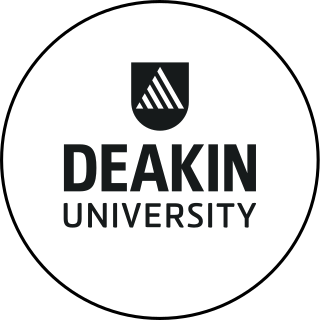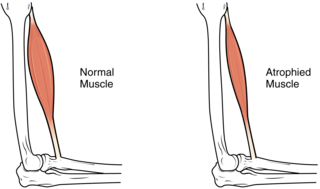Related Research Articles

Osteoporosis is a systemic skeletal disorder characterized by low bone mass, micro-architectural deterioration of bone tissue leading to bone sterility, and consequent increase in fracture risk. It is the most common reason for a broken bone among the elderly. Bones that commonly break include the vertebrae in the spine, the bones of the forearm, the wrist, and the hip. Until a broken bone occurs there are typically no symptoms. Bones may weaken to such a degree that a break may occur with minor stress or spontaneously. After the broken bone heals, the person may have chronic pain and a decreased ability to carry out normal activities.

Human nutrition deals with the provision of essential nutrients in food that are necessary to support human life and good health. Poor nutrition is a chronic problem often linked to poverty, food security, or a poor understanding of nutritional requirements. Malnutrition and its consequences are large contributors to deaths, physical deformities, and disabilities worldwide. Good nutrition is necessary for children to grow physically and mentally, and for normal human biological development.

A dietary supplement is a manufactured product intended to supplement a person's diet by taking a pill, capsule, tablet, powder, or liquid. A supplement can provide nutrients either extracted from food sources, or that are synthetic. The classes of nutrient compounds in supplements include vitamins, minerals, fiber, fatty acids, and amino acids. Dietary supplements can also contain substances that have not been confirmed as being essential to life, and so are not nutrients per se, but are marketed as having a beneficial biological effect, such as plant pigments or polyphenols. Animals can also be a source of supplement ingredients, such as collagen from chickens or fish for example. These are also sold individually and in combination, and may be combined with nutrient ingredients. The European Commission has also established harmonized rules to help insure that food supplements are safe and appropriately labeled.

Deakin University is a public university in Victoria, Australia. Founded in 1974, the university was named after Alfred Deakin, the second Prime Minister of Australia.

A multivitamin is a preparation intended to serve as a dietary supplement with vitamins, dietary minerals, and other nutritional elements. Such preparations are available in the form of tablets, capsules, pastilles, powders, liquids, or injectable formulations. Other than injectable formulations, which are only available and administered under medical supervision, multivitamins are recognized by the Codex Alimentarius Commission as a category of food.

A healthy diet is a diet that maintains or improves overall health. A healthy diet provides the body with essential nutrition: fluid, macronutrients such as protein, micronutrients such as vitamins, and adequate fibre and food energy.

Osteopenia, known as "low bone mass" or "low bone density", is a condition in which bone mineral density is low. Because their bones are weaker, people with osteopenia may have a higher risk of fractures, and some people may go on to develop osteoporosis. In 2010, 43 million older adults in the US had osteopenia. Unlike osteoporosis, osteopenia does not usually cause symptoms, and losing bone density in itself does not cause pain.

An underweight person is a person whose body weight is considered too low to be healthy. A person who is underweight is malnourished.

Sarcopenia is a type of muscle loss that occurs with aging and/or immobility. It is characterized by the degenerative loss of skeletal muscle mass, quality, and strength. The rate of muscle loss is dependent on exercise level, co-morbidities, nutrition and other factors. The muscle loss is related to changes in muscle synthesis signalling pathways. It is distinct from cachexia, in which muscle is degraded through cytokine-mediated degradation, although both conditions may co-exist. Sarcopenia is considered a component of frailty syndrome. Sarcopenia can lead to reduced quality of life, falls, fracture, and disability.

Relative energy deficiency in sport (RED-S) is a syndrome in which disordered eating, amenorrhoea/oligomenorrhoea, and decreased bone mineral density are present. It is caused by eating too little food to support the amount of energy being expended by an athlete, often at the urging of a coach or other authority figure who believes that athletes are more likely to win competitions when they have an extremely lean body type. RED-S is a serious illness with lifelong health consequences and can potentially be fatal.

Frailty is a common geriatric syndrome that embodies an elevated risk of catastrophic declines in health and function among older adults. Frailty is a condition associated with ageing, and it has been recognized for centuries. It is a marker of a more widespread syndrome of frailty, with associated weakness, slowing, decreased energy, lower activity, and, when severe, unintended weight loss. As a frequent clinical syndrome in the elderly, various health risks are linked to health deterioration and frailty in older age, such as falls, disability, hospitalization, and mortality. Generally, frailty refers to older adults who lose independence. It also links to the experiences of losing dignity due to social and emotional isolation risk. Frailty has been identified as a risk factor for the development of dementia.

Vitamin D deficiency or hypovitaminosis D is a vitamin D level that is below normal. It most commonly occurs in people when they have inadequate exposure to sunlight, particularly sunlight with adequate ultraviolet B rays (UVB). Vitamin D deficiency can also be caused by inadequate nutritional intake of vitamin D; disorders that limit vitamin D absorption; and disorders that impair the conversion of vitamin D to active metabolites, including certain liver, kidney, and hereditary disorders. Deficiency impairs bone mineralization, leading to bone-softening diseases, such as rickets in children. It can also worsen osteomalacia and osteoporosis in adults, increasing the risk of bone fractures. Muscle weakness is also a common symptom of vitamin D deficiency, further increasing the risk of fall and bone fractures in adults. Vitamin D deficiency is associated with the development of schizophrenia.

Vitamin D is a group of fat-soluble secosteroids responsible for increasing intestinal absorption of calcium, magnesium, and phosphate, and for many other biological effects. In humans, the most important compounds in this group are vitamin D3 (cholecalciferol) and vitamin D2 (ergocalciferol).

Taylor C. Wallace is an American food and nutrition scientist and media personality. Wallace is the principal consultant at the Think Healthy Group, an adjunct clinical associate professor in the School of Medicine and Health Sciences at George Washington University, and an adjunct associate professor in the Gerald J. And Dorothy R. Friedman School of Nutrition Science and Policy at Tufts University. Wallace has previously served in senior staff positions at The National Osteoporosis Foundation, and Council for Responsible Nutrition. He serves as the Editor-in-chief of the Journal of Dietary Supplements and has authored over 100 research studies.
Elvie Marelyn Wintour-Coghlan is an Australian physiologist who has focused her career on the endocrinology of the pregnant mother and foetus. She has developed techniques enabling her to follow development of foetal organs, showing that concentration of foetal urine can be used as an indicator of stress in the foetus. The important focus of her work was the discovery that foetal stressful conditions can be translated into adult health.
Nutrition is the intake of food, considered in relation to the body's dietary needs. Well-maintained nutrition includes a balanced diet as well as a regular exercise routine. Nutrition is an essential aspect of everyday life as it aids in supporting mental as well as physical body functioning. The National Health and Medical Research Council determines the Dietary Guidelines within Australia and it requires children to consume an adequate amount of food from each of the five food groups, which includes fruit, vegetables, meat and poultry, whole grains as well as dairy products. Nutrition is especially important for developing children as it influences every aspect of their growth and development. Nutrition allows children to maintain a stable BMI, reduces the risks of developing obesity, anemia and diabetes as well as minimises child susceptibility to mineral and vitamin deficiencies.

Obesity is defined as the excessive accumulation of fat and is predominantly caused when there is an energy imbalance between calorie consumption and calorie expenditure. Childhood obesity is becoming an increasing concern worldwide, and Australia alone recognizes that 1 in 4 children are either overweight or obese.
David Joshua Handelsman, (AO) is trained in Medicine and Endocrinology. His expertise is in testicular function and androgen physiology, pharmacology, and toxicology. His experience spans basic, clinical, and public health domains including a recent focus on genetic models of androgen action, steroid mass spectrometry, and anti-doping science. He was Australia's first Professor in Reproductive Endocrinology and Andrology. He has worked in the US, Australia, and Germany. His professional involvement includes the World Health Organisation (WHO) Human Reproduction Programme's Male Task Force, WHO Human Reproduction Programme, United Nations Fund for Population Activities, Endocrine Society of Australia, World Anti-Doping Agency's Health, Medicine and Research Committee, and Australian Drug Evaluation Committee.

Bahram H. Arjmandi is an American nutritionist. He is the Margaret A. Sitton Professor at Florida State University (FSU) and is the founder and Director of the Center for Advancing Exercise and Nutrition Research on Aging (CAENRA). He is a researcher in the fields of functional foods and human health. He was among the first to detect the presence of estrogen receptors in the gut linking the importance of estrogen and estrogen receptors in calcium regulation independent of vitamin D.
Joel K. Kahn is an American cardiologist, integrative medicine practitioner and promoter of plant-based nutrition.
References
- ↑ APD https://dietitiansaustralia.org.au/what-dietitans-do/choosing-your-nutrition-expert/
- ↑ "School of Exercise and Nutrition Sciences". Archived from the original on 14 August 2014. Retrieved 14 August 2014. School of Exercise and Nutrition Sciences], www.deakin.edu.au
- ↑ (C-PAN), www.deakin.edu.au
- ↑ Kayne Richens. "Publications Collection". Deakin.edu.au. Retrieved 14 August 2014.
- ↑ Vitamin D and health in adults in Australia and New Zealand: a position statement, www.mja.com.au
- ↑ Nutrition, Deakin. "Food fortification with vitamin D: a public health issue for Australians". Deakinnutrition.wordpress.com. Retrieved 14 August 2014.
- ↑ "Professor Caryl Nowson". Archived from the original on 14 August 2014. Retrieved 14 August 2014.
- ↑ Deakin University (8 October 2012). "Newsroom". Deakin.edu.au. Archived from the original on 14 August 2014. Retrieved 14 August 2014.
- ↑ Elizabeth DeVita Raeburn (19 March 2014). "Higher BMI May Be Better for Older Adults". Medpagetoday.com. Retrieved 14 August 2014.
- ↑ "Carrying extra weight could be healthier for older people". Deakin.edu.au. Retrieved 14 August 2014.
- ↑ Australian Division of the World Action group on Salt and Health (AWASH), www.awash.org.au
- ↑ Nutrition Society of Australia Medal, www.nsa.asn.au
- ↑ National Committee for Nutrition Archived 2014-07-15 at the Wayback Machine , www.science.org.au
- ↑ "Medical & Scientific Committee - Osteoporosis Australia". osteoporosis.org.au. Retrieved 14 August 2014.
- ↑ Osteoporosis Australia, www.osteoporosis.org.au